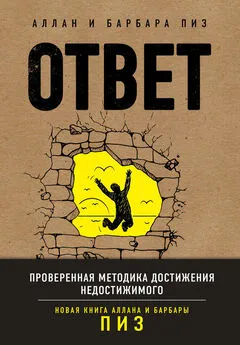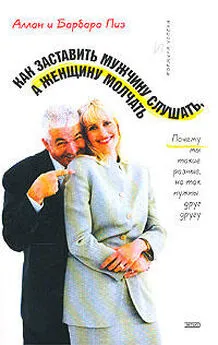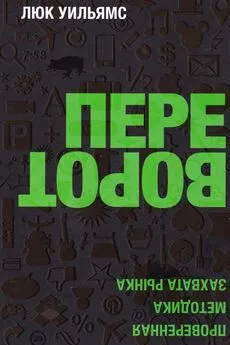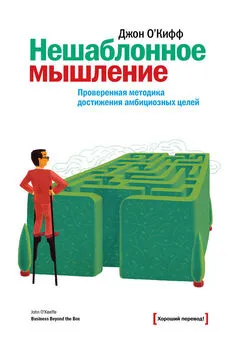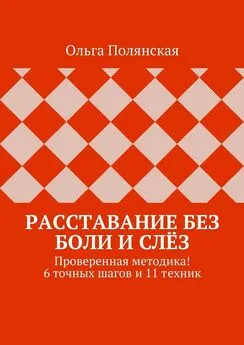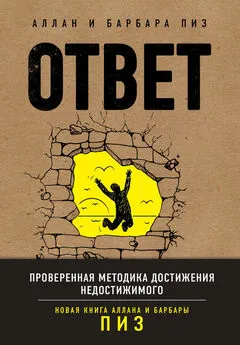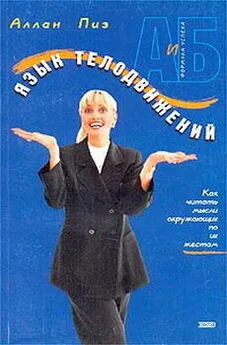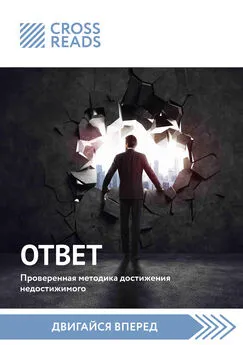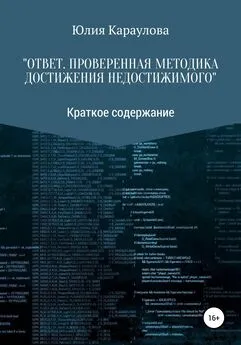Алан Пиз - Ответ. Проверенная методика достижения недостижимого
- Название:Ответ. Проверенная методика достижения недостижимого
- Автор:
- Жанр:
- Издательство:Э
- Год:2017
- Город:Москва
- ISBN:978-5-699-96984-5
- Рейтинг:
- Избранное:Добавить в избранное
-
Отзывы:
-
Ваша оценка:
Алан Пиз - Ответ. Проверенная методика достижения недостижимого краткое содержание
Эта книга даст вам ответ на вопросы:
Почему я оказался там, где нахожусь, и куда двигаться дальше?
Чего я на самом деле хочу от жизни и как это получить?
Как перестать реагировать на манипуляции окружающих и стать хозяином своей жизни?
Как обходить препятствия и достигать того, что кажется недостижимым?
Ответ. Проверенная методика достижения недостижимого - читать онлайн бесплатно ознакомительный отрывок
Интервал:
Закладка:
Janssen, J. & Sheikh, A. (1994). ‘Enhancing athletic performance through imagery: An overview’. In A. A. Sheikh & E. R. Korn (eds), Imagery and Sport Physical Performance (Amityville, NY: Bayood Publishing), pp. 1–22.
Jones, G. (1995). ‘More than just a game: Research developments and issues in competitive anxiety in sport’. British Journal of Psychology 86: 449–478.
Klein, I., Paradis, A., Poline, J., Kosslyn, S. & LeBihan, D. (2000). ‘Transient activity in human calcarine cortex during visual imagery’. Journal of Cognitive Neuroscience 12: 15–23.
Kosslyn, S., Ganis, G. & Thompson, W. (2001). ‘Neural foundations of imagery’. Nature Reviews Neuroscience 2: 635–642.
Kosslyn, S., Thompson, W., Kim, I. & Alpert, N. (1995). ‘Topographical representations of mental images in primary visual cortex’. Nature 3: 496–498.
Lambert, S. (1996). ‘The effects of hypnosis/guided imagery on the postoperative course of children’. Journal of Developmental and Behavioral Pediatrics 17: 307–310.
Lang, P. (1979). ‘A bioinformational theory of emotional imagery’. Psychophysiology 16: 495–512.
Lang. P., Kozak, M., Miller, G., Levin, D. & McLean, A. (1980). ‘Emotional imagery: Conceptual structure and pattern of somatovisceral response’. Psychophysiology 17: 179–192.
Lang, P., Levin, D., Miller, G. & Kozak, M. (1983). ‘Fear behavior, fear imagery, and the psychophysiology of emotion: The problem of affective response integration’. Journal of Abnormal Psychology 92: 276–306.
Lohr, B. & Scogin, F. (1998). ‘Effects of self-administered visuomotor behavioural rehearsal on sport performance of collegiate athletes’. Journal of Sport Behaviour 21 (2): 206–218.
MacKay, D. (1981). ‘The problem of rehearsal or mental practice’. Journal of Motor Behavior 13: 274–285.
Mahoney, M., & Avener, M. (1977). Psychology of the elite athlete: an exploratory study. Cognitive Therapy and Research 1: 135–141.
Malone, M. & Strube, M. (1988). ‘Meta-analysis of non-medical treatment for chronic pain’. Pain 34: 231–234.
Malouff, J., McGee, J., Halford, H. & Rooke, S. (2008). ‘Effects of pre-competition positive imagery and self-instructions on accuracy of serving in tennis’. Journal of Sport Behavior 31 (3): 264–275.
Mamassis, G. & Doganis, G. (2004). ‘Effects of a mental training program on juniors pre-competitive anxiety, self-confidence, and tennis performance’. Journal of Applied Sport Psychology 16: 118–137.
Marks, D. (1983). ‘Mental imagery and consciousness: A theoretical review’. In A. Sheikh (ed.), Imagery: Current Theory, Research, and Application (New York: Wiley), pp. 96–130.
Martin, K. & Hall, C. (1995). ‘Using mental imagery to enhance intrinsic motivation’. Journal of Sport and Exercise Psychology 17: 54–69.
Martin, K., Moritz, S. & Hall, C. (1999). ‘Imagery use in sport: A literature review and applied model’. The Sport Psychologist 13: 245–268.
Mauer, M., Burnett, K., Oulette, E., Ironson, G. & Dandes, H. (1999). ‘Medical hypnosis and orthopedic hand surgery: Pain perception, postoperative recovery, and therapeutic comfort’. International Journal of Clinical and Experimental Hypnosis 47: 144–161.
Moritz, S., Hall, C., Martin, K. & Vadocz, E. (1996). ‘What are confident athletes imagining: An examination of image content’. The Sport Psychologist 10: 171–179.
Munroe, K., Giacobbi, P., Hall, C. & Weinberg, R. (2000). ‘The four W’s of imagery use: where, when, why, and what’. The Sport Psychologist 14: 119–137.
Munroe-Chandler, K. & Hall, C. (2007). ‘Psychological interventions in sport’. In P. Crocker (ed.), Introduction to Sport Psychology: A Canadian Perspective (Toronto, ON: Pearson).
Murphy, S. & Jowdy, D. (1992). ‘Imagery and mental practice’. In T. S. Horn (ed.), Advances in Sport Psychology (Champaign, IL: Human Kinetics), 2nd edn, pp. 221–250.
Murphy, S. & Martin, K. (2002). ‘The use of imagery in sport’. In T. Horn (ed.), Advances in Sport Psychology (Champaign, IL: Human Kinetics), 2nd edn, pp. 405–439.
Nideffer, R. (1994). Psyched to Win (Champaign, IL: Human Kinetics).
Nideffer, R. & Sagal, M. (2006). ‘Concentration and attention control training’. In J. M. Williams (ed.), Applied Sport Psychology: Personal Growth to Peak Performance (Boston, MA: McGraw-Hill), 4th edn, pp. 312–332.
Noel, R. (1980). ‘The effect of visuo-motor behaviour rehearsal on tennis performance’. Journal of Sport Psychology 2: 221–226.
Onestak, D. (1997). ‘The effect of visuo-motor behavior rehearsal (VMBR) and videotaped modeling (VM) on the freethrow performance of intercollegiate athletes’. Journal of Sport Behaviour 20 (2): 185–198.
Paivio, A. (1985). ‘Cognitive and motivational functions of imagery in human performance’. Canadian Journal of Applied Sport Science 10: 22–28.
Richardson, Alan. (1984). The Experiential Dimension of Psychology (Queensland, Australia: University of Queensland Press).
Rizzolatti, G., Fogassi, L. & Gallese, V. (2001). ‘Neurophysiological mechanisms underlying the understanding and imitation of action’. Nature Neuroscience Reviews 2: 661–670.
Robin, N., Dominique, L., Toussaint, L., Blandin, Y., Guillot, A. & Le Her, M. (2007). ‘Effects of motor imagery training on service return accuracy in tennis: the role of imagery ability’. International Journal of Sport and Exercise Psychology 5 (2): 175–188.
Rogerson, L. & Hrycaiko, D. (2002). ‘Enhancing competitive performance in ice hockey goaltenders using centering and selftalk’. Journal of Applied Sport Psychology 14: 14–26.
Roos, H., Ornell, M., Gardsell, P., Lohmander, L. & Lindstrand, A. (1995). ‘Soccer after anterior cruciate ligament injury – an incompatible combination? A national survey of incidence and risk factors and a 7-year follow-up of 310 players.’ Scandinavian Journal of Medicine and Science in Sports 5: 107–112.
Rotella, R., Gansneder, B., Ojala, D. & Billing, J. (1980). ‘Cognitions and coping strategies of elite skiers. An exploratory study of young developing athletes.’ J ournal of Sport Psychology 2: 350–354.
Rushall, B. & Lippman, L. (1998). ‘The role of imagery in physical performance’. International Journal of Sport Psychology 29: 57–72.
Ryan, D. & Simons, J. (1982). ‘Efficacy of mental imagery in enhancing mental rehearsal of motor skills’. Journal of Sport Psychology 4: 41–51.
Ryan, D. & Simons, J. (1983). ‘What is learned in mental practice of motor skills’. Journal of Sport Psychology 5: 219–426.
Sackett, R. (1934). ‘The influences of symbolic rehearsal upon the retention of a maze habit’. Journal of General Psychology 13: 113–128.
Sheikh, A. & Korn, E. (1994). Imagery in Sports and Physical Performance (Amityville, NY: Baywood).
Short, S., Bruggeman, J., Engel, S., Marback, T., Wang, L., Willadsen, A. & Short, M. (2002). ‘The effect of imagery function and imagery direction on self-efficacy and performance on a golf-putting task’. The Sport Psychologist 16: 48–67.
Smith, D., Collins, D. & Holmes, P. (2003). ‘Impact and mechanism of mental practice effects on strength’. International Journal of Sport and Exercise Psychology 1: 293–306.
Suinn, R. (1982). ‘Imagery in sports’. In A. Sheikh (ed.), Imagery, Current Theory, Research, and Application (New York: Wiley), pp. 507–534.
Surburg, P., Porretta, D. & Sutlive, V. (1995). ‘Use of imagery practice for improving a motor skill’. Adapted Physical Activity Quarterly 12 (3): 217–227.
Taylor, J. & Taylor, S. (1997). Psychological Approaches to Sports Injury Rehabilitation (Gaithersburg, MD: Aspen).
Taylor, J. & Wilson, G. (2005). Applying Sport Psychology: Four Perspectives (Champaign, IL: Human Kinetics).
Vadocz, E., Hall, C. & Moritz, S. (1997). ‘The relationship between competitive anxiety and imagery use’. Journal of Applied Sport Psychology 9 (2): 241–253.
Vealey, R. & Greenleaf, C. (1998). ‘Seeing is believing: Understanding and using imagery in sport’. In J. M. Williams (ed.), Applied Sport Psychology: Personal Growth to Peak Performance (Boston, MA: McGraw-Hill), pp. 220–224.
Weinberg, R. & Gould, D. (2006). Foundations of Sport and Exercise Psychology (Champaign, IL: Human Kinetics), 4th edn.
Weinberg, R., Seabourne, T. & Jackson, A. (1981). ‘Effect of visuomotor behavior rehearsal, relaxation, and imagery on karate performance’. Journal of Sport Psychology 10: 71–78.
White, A. & Hardy, L. (1995). ‘Use of different imagery perspectives on the learning and performance of different motor skills’. British Journal of Psychology 86: 191–216.
Wrisberg, C. & Ragsdale, M. (1979). ‘Cognitive demand and practice level: Factors in the mental rehearsal of motor skills’. Journal of Human Movement Studies 5: 201–208.
Zittman, F., Dyck, R., Spinhoven, P., Linssen, A. & Corrie, G. (1992). ‘Hypnosis and autogenic training in the treatment of tension headaches: A two-phase constructive design study with follow-up’. Journal of Psychosomatic Research 36: 219–228.
http://scholar.lib.vt.edu/ejournals/JITE/v32n4/whetstone.html
https://www.psychologytoday.com/blog/flourish/200912/seeing-isbelieving-the-power-visualization
Barnes, G. M., Welte, J. W., Tidwell, M. C. & Hoffman, J. H. (2011). ‘Gambling on the Lottery: Sociodemographic Correlates Across the Lifespan’. Journal of Gambling Studies 27 (4): 575–86. doi: 10.1007/s10899-010-9228-7.
http://fortune.com/2016/01/15/powerball-lottery-winners/
http://www.theghostcoders.com/799/you-just-won-a-lottery-10shocking-factsabout-the-lottery
http://journalistsresource.org/studies/economics/personal-finance/research-review-lotteries-demographics#sthash.ojrlp1te.dpuf
Artherholt, S. B. & Fann, J. R. (2012). ‘Psychosocial care in cancer’. Current Psychiatry Reports 14 (1): 23–29.
Bachorowski, J.-A., Smoski, M. J. & Owren, M. J. (2001). ‘The acoustic features of human laughter’. Journal of the Acoustical Society of America 110: 1581.
Bakhtin, Mikhail (1941). Rabelais and His World (Bloomington: Indiana University Press).
Bogard, M. (2008). Laughter and its Effects on Groups (New York: Bullish Press).
Chapman, Antony J., Foot, Hugh C. & Derks, Peter (eds) (1996). Humor and Laughter: Theory, Research, and Applications (NJ. Transaction Publishers).
Cousins, Norman (1979). Anatomy of an Illness as Perceived by the Patient (New York. WW Norton).
Cousins, Norman (1983). Anatomy of an Illness (New York: Bantam Doubleday Dell).
Davila-Ross, M., Allcock, B., Thomas, C. & Bard, K. A. (2011). ‘Aping expressions? Chimpanzees produce distinct laugh types when responding to laughter of others.’ Emotion . Oct;11(5):1013- 20. doi:10.1037/a0022594.
Fashoyin-Aje, L. A., Martinez, K. A. & Dy, S. M. (2012). ‘New patient-centered care standards from the Commission on Cancer: opportunities and challenges’. Journal of Supportive Oncology : e-pub ahead of print 20 March 2012. http://www.ncbi.nlm.nih.gov/pubmed/22440532
Читать дальшеИнтервал:
Закладка:
